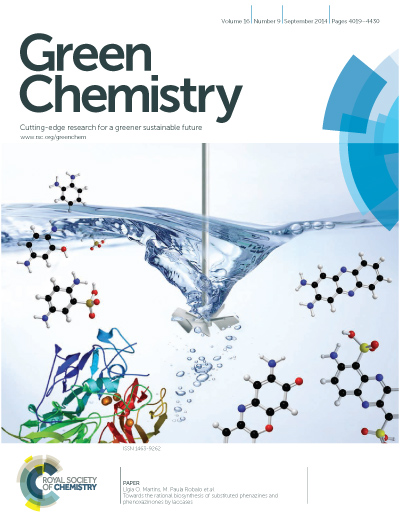Enzymes for a greener chemistry
Oeiras, 09.09.2014
The September issue of Green Chemistry highlights on its cover a study involving the Lab of Microbial and Enzyme Technology at ITQB, the Instituto Superior de Engenharia de Lisboa and the Instituto Superior Técnico. The paper shows how the enzyme laccase, widely studied at ITQB, is an efficient and greener alternative for the chemical oxidation of aromatic amines.
The oxidation products of aromatic amines, the heterocyclic phenazines and phenoxazinones, are important biological active motifs of antibiotics and antibacterial agents, anti-tumour agents, pesticides, dyestuffs, biosensors, and are the building blocks for the synthesis of organic semiconductors or electrical-photochemical materials. With such a wide range of applications, the bio-oxidation process is of great interest from the biological, chemical and technological points of view and efficient environmentally friendly alternatives are on demand.
Different chemical methods exist for the synthesis of these compounds but most suffer from a number of disadvantages, such as the use of organic solvents, the requirement for harsh reaction conditions and, despite some progress, low production yields. Enzyme catalyzed processes, on the other hand, are steadily growing as many enzyme-catalysed reactions meet the criteria of green chemistry. Laccases in particular are an attractive option; laccase-catalyzed reactions occur in aqueous systems under mild reaction pH and temperature conditions, and the only waste product formed during the course of their reactions is water.
In this work, researchers were able to demonstrate the efficiency of CotA-laccase to mediate the synthesis of a diversity of phenazine and phenoxazinone molecules with corresponding good to excellent yields. Moreover, the results allowed proposing a pathway for laccase catalysed oxidation of substituted aromatic substrates and, as noted in the conclusion of the paper, “a green chemistry process (…) providing a promising approach for the rational synthesis of different heterocyclic scaffolds”.

Original Article
Green Chem., 2014, 16, 4127-4136
Towards the rational biosynthesis of substituted phenazines and phenoxazinones by laccases
Ana Catarina Sousa, M. Conceição Oliveira, Lígia O. Martins, and M. Paula Robalo







